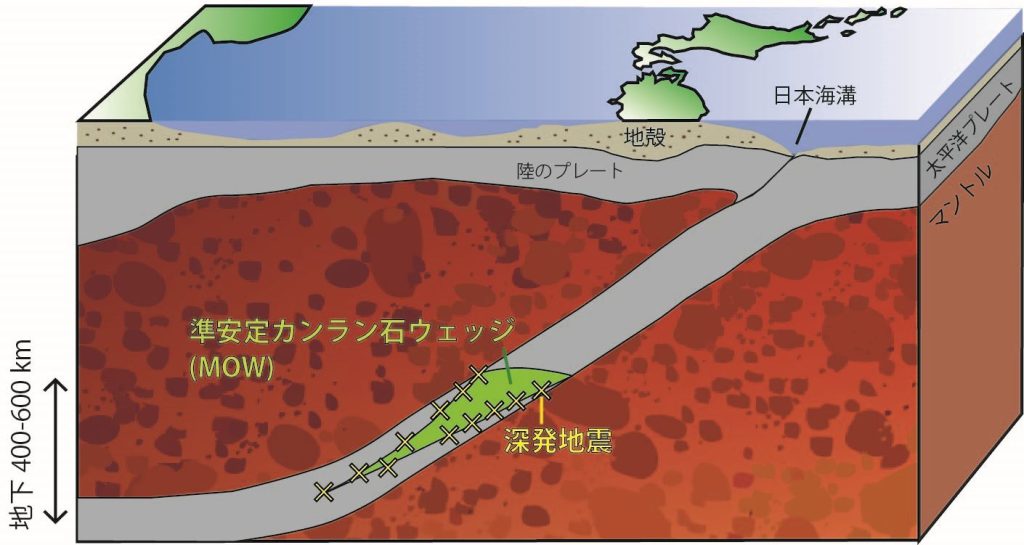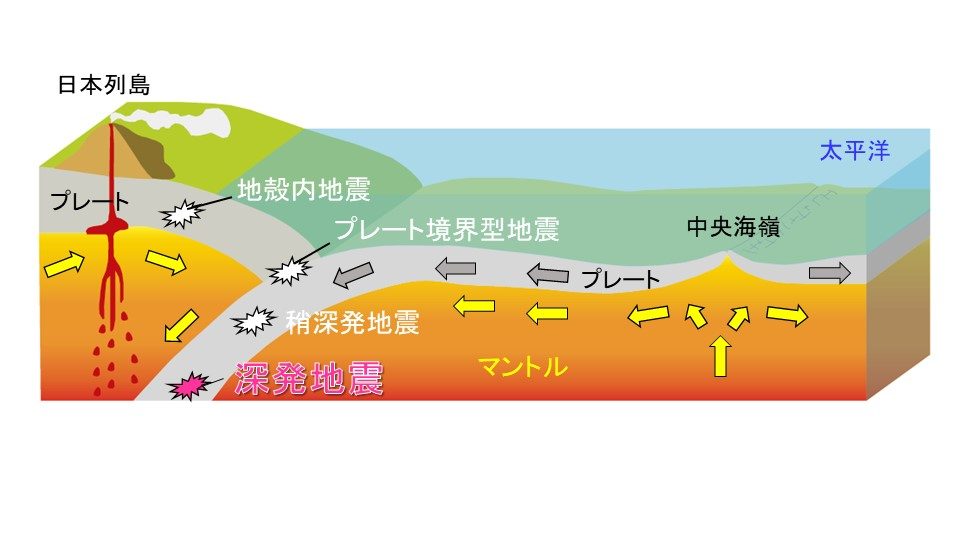Making mini earthquakes in the lab
※The content is current at the time of writing.
Elucidate the process of earthquake generation through high temperature and high pressure experiments to reproduce the environment of deep seismogenic field.
Research Overview

The dozens of plates (about 60 km thick) that cover the surface of our planet move with the hot mantle beneath them. Earthquakes occur when plates collide with each other and sink deeper into the subsurface.
Earthquakes are classified according to the depth and location of their epicenter (Figure 1). Shallow earthquakes that occur near the surface (10-50 km below the surface) occur frequently at plate boundaries or directly under land, causing tsunamis and direct earthquakes. Deep earthquakes, on the other hand, occur inside subducting plates at depths of 300 km or more, but are less frequent.
However, when they do occur, they often reach magnitude 7 and are known for their unique characteristics, such as being accompanied by “anomalous seismic zones” (places where strong tremors are observed even though they are far from the epicenter). In general, earthquakes are less likely to occur with depth, but it is also known that the frequency of deep earthquakes is exceptionally high at depths of 400 to 600 km. It has been believed that deep earthquakes are triggered by pressure-induced changes in the crystal structure of olivine (the most abundant mineral in the plate and upper mantle). However, experiments to prove this hypothesis have been technically difficult because a depth of 400 to 600 km corresponds to a high-pressure environment of 13 to 20 GPa.
Research Features
The most effective way to prove this hypothesis is to experimentally reproduce “acoustic emissions (AE),” which are mini deep-focus earthquakes in the laboratory. My research group has successfully detected AEs by conducting olivine deformation experiments at SPring-8 under temperature and pressure conditions (600-1100°C, 13-16 GPa) that correspond to the interior of a plate at depths of 390-470 km, where deep earthquakes frequently occur. This proves that a fault was formed in the sample during the experiment, i.e., that an earthquake was artificially achieved in the experiment under the temperature conditions that cause actual deep earthquakes.
Observations of experimental samples using synchrotron radiation X-rays confirmed that olivine forms a brittle layer composed of nanoparticles at certain temperatures (around 850°C) during pressure-induced structural changes in the crystal structure of olivine. The local concentration of deformation energy in the brittle layer causes the olivine to melt at a momentarily high temperature of 2,400°C, resulting in the formation of faults and earthquakes (Fig. 2).
The results of this study are consistent with the predictions of previous studies using olivine simulants and indicate that the occurrence of deep earthquakes is limited to a specific area in the deep plate (near the surface of a region called “metastable olivine wedge (MOW)” (Figure 3)). The presence of MOW can be detected by seismic observation networks, and intensive monitoring of this area is expected to provide clues for modeling the location, frequency, and magnitude of deep earthquakes in the future.

Center: fault slipped by a fragile layer filled with olivine and wadsleyite (a mineral whose crystalline structure has changed from olivine due to pressure) nanoparticles.
Right: enlarged view of the brittle layer. Iron (Fe: green) rich partial melt melt can be seen between olivine nanoparticles.

Based on the results of this study, the occurrence of deep earthquakes is expected to be limited to near the surface of the MOW.
Research Attraction
What is the process by which not only deep earthquakes but also shallow earthquakes occur? What triggers them? and “What triggers them?” are mysteries that are not fully understood. The destructive processes that cause earthquakes are extremely difficult to observe in the laboratory “without missing something” because they occur on short time scales of sub-seconds to seconds. Moreover, since the fracture process is taking place in a pressure vessel under high temperature and high pressure, it is not easy to observe the process “without missing anything. Such observation technology was once thought to be unfeasible, but is now being realized through technological innovation that combines the ultra-powerful synchrotron radiation X-rays of SPring-8 with a dedicated high-speed camera. If the details of the earthquake generation process can be elucidated, clues may be found that will lead to the prediction of earthquakes.
Message to those who are interested in this research
Every time there is an earthquake disaster, you may see or hear comments from experts on TV programs or in magazine articles to the effect that “it is impossible to predict the occurrence of earthquakes. However, as an expert in “material science of earthquake occurrence fields,” I believe that “the reality is that we do not even know if it is possible to predict the occurrence of earthquakes at the current academic level. The field is still in its infancy, and there are still many problems to be solved. Even seemingly insoluble problems can be solved through steady accumulation of related research and technological development. Although it requires perseverance, material science of seismogenic fields is a challenging research field.


